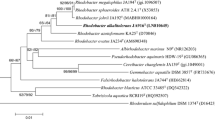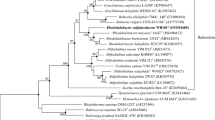Abstract.
A new species of purple nonsulfur bacteria isolated from an Antarctic microbial mat is described. The organism, designated strain ANT.BR, was mildly psychrophilic, growing optimally at 15–18 °C with a growth temperature range of 0–25 °C. Cells of strain ANT.BR were highly motile curved rods and spirals, contained bacteriochlorophyll a, and showed a multicomponent in vivo absorption spectrum. A specific phylogenetic relationship was observed between strain ANT.BR and the purple bacterium Rhodoferax fermentans FR2T, and the two organisms shared several physiological and other phenotypic properties, with the notable exception of growth temperature optimum. Tests of genomic DNA hybridization, however, showed Rfx. fermentans FR2T and strain ANT.BR to be genetically distinct bacteria. Because of its unique set of properties, especially its requirement for low growth temperatures, we propose to recognize strain ANT.BR as a new species of the genus Rhodoferax, Rhodoferax antarcticus, named for its known habitat, the Antarctic.
Similar content being viewed by others
Author information
Authors and Affiliations
Additional information
Electronic Publication
An erratum to this article is available at http://dx.doi.org/10.1007/s002030000168.
Rights and permissions
About this article
Cite this article
Madigan, M., Jung, D., Woese, C. et al. Rhodoferax antarcticus sp. nov., a moderately psychrophilic purple nonsulfur bacterium isolated from an Antarctic microbial mat. Arch Microbiol 173, 269–277 (2000). https://doi.org/10.1007/s002030000140
Received:
Revised:
Accepted:
Issue Date:
DOI: https://doi.org/10.1007/s002030000140




